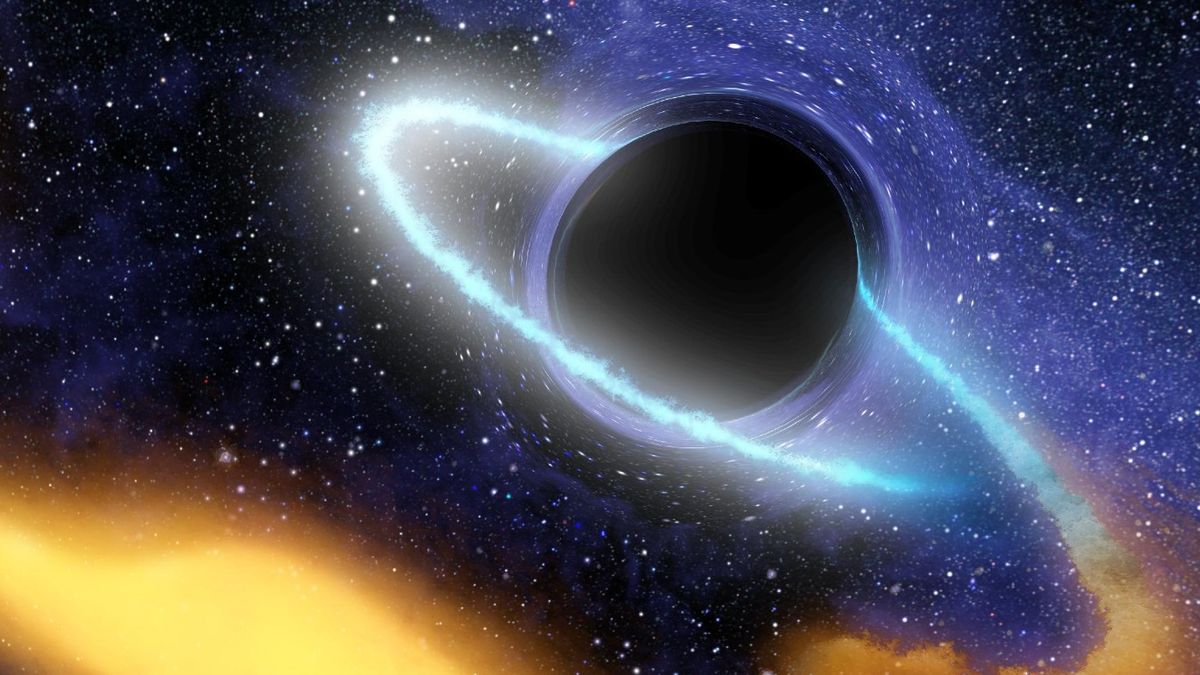Science
Related: About this forumStrange star system may hold first evidence of an ultra-rare 'dark matter star'
By Paul Sutter published 23 May 2023
In a distant star system, a sunlike star orbits an invisible object that may be the first example of a 'boson star' made of dark matter, new research suggests.

An illustration of a supermassive black hole at the center of a galaxy. (Image credit: NASA/JPL-Caltech)
Astronomers long thought that a peculiar star system observed by the European Space Agency's Gaia satellite was a simple case of a star orbiting a black hole. But now, two astronomers are challenging that claim, finding that the evidence suggests something far stranger: possibly, a never-before-seen type of star made of invisible dark matter. Their research, which has yet to be peer-reviewed, was published April 18 on the preprint server arXiv.
The system itself consists of a sunlike star and, well, something else. The star weighs a little less than the sun (0.93 solar mass) and has roughly the same chemical abundance as our star. Its mysterious companion is much more massive — around 11 solar masses. The objects orbit each other at a distance of 1.4 astronomical units, about the distance at which Mars orbits the sun, making a complete orbit every 188 days.
What could that dark companion be? One possibility is that it's a black hole. While that would easily fit the bill in terms of the orbital observations, that hypothesis has challenges. Black holes form from the deaths of very massive stars, and for this situation to arise, a sunlike star would have to form in companionship with one of those monsters. While not outright impossible, that scenario requires an extraordinary amount of fine-tuning to make the match happen and to keep these objects in orbit around each other for millions of years.
So perhaps that dark orbital companion is something much more exotic, as researchers propose in the new study. Maybe, they suggest, it's a clump of dark matter particles.
More:
https://www.livescience.com/space/black-holes/strange-star-system-may-hold-first-evidence-of-an-ultra-rare-dark-matter-star
xocetaceans
(4,345 posts)Just kidding, nice post.
Here is the article-referenced preprint:
A Sun-like star orbiting a boson star
Alexandre M. Pombo, Ippocratis D. Saltas
The high-precision astrometric mission GAIA recently reported the remarkable discovery of a Sun-like star closely orbiting a dark object, with a semi-major axis and period of 1.4AU and 187.8 days respectively. While the plausible expectation for the central dark object is a black hole, the evolutionary mechanism leading to the formation of such a two-body system is highly challenging. Here, we challenge the scenario of a central black hole and show that the observed orbital dynamics can be explained under fairly general assumptions if the central dark object is a stable clump of bosonic particles of spin-0, or spin-1, known as a boson star. We further explain how future astrometric measurements of similar systems will provide an exciting opportunity to probe the fundamental nature of compact objects and test compact alternatives to black holes.
...
https://arxiv.org/abs/2304.09140
tirebiter
(2,666 posts)Response to Judi Lynn (Original post)
tirebiter This message was self-deleted by its author.
LudwigPastorius
(14,152 posts)formed at the same time, what rules out a black hole capturing a star at a later date?
That would seem to be a simpler solution than inventing a new kind of stellar object.